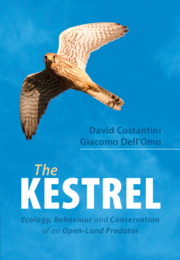Book contents
- The Kestrel
- The Kestrel
- Copyright page
- Contents
- Preface
- 1 Systematics and Evolution of Kestrels
- 2 Feeding Ecology
- 3 Habitat Use
- 4 Breeding Density and Nest Site Selection
- 5 Colourations, Sexual Selection and Mating Behaviour
- 6 The Reproductive Cycle: From Egg Laying to Offspring Care
- 7 Ecological Physiology and Immunology
- 8 Environmental Toxicology
- 9 Movement Ecology
- 10 Conservation Status and Population Dynamics
- References
- Index
- Plate Section (PDF Only)
8 - Environmental Toxicology
Published online by Cambridge University Press: 29 August 2020
- The Kestrel
- The Kestrel
- Copyright page
- Contents
- Preface
- 1 Systematics and Evolution of Kestrels
- 2 Feeding Ecology
- 3 Habitat Use
- 4 Breeding Density and Nest Site Selection
- 5 Colourations, Sexual Selection and Mating Behaviour
- 6 The Reproductive Cycle: From Egg Laying to Offspring Care
- 7 Ecological Physiology and Immunology
- 8 Environmental Toxicology
- 9 Movement Ecology
- 10 Conservation Status and Population Dynamics
- References
- Index
- Plate Section (PDF Only)
Summary
Many types of chemical pollutants biomagnify across the food chain and reach their highest levels in predators such as kestrels. In urban and suburban environments, kestrels are also being exposed to non-chemical pollutants (e.g. electromagnetic fields, light and noise pollution), which are becoming a growing concern. This chapter summarises the ways through which a range of chemical and non-chemical pollutants may influence the behaviour, physiology and reproduction of kestrels, and describes how patterns of population recovery have followed the control and withdrawal of some chemical pollutants.
Keywords
- Type
- Chapter
- Information
- The KestrelEcology, Behaviour and Conservation of an Open-Land Predator, pp. 134 - 145Publisher: Cambridge University PressPrint publication year: 2020

